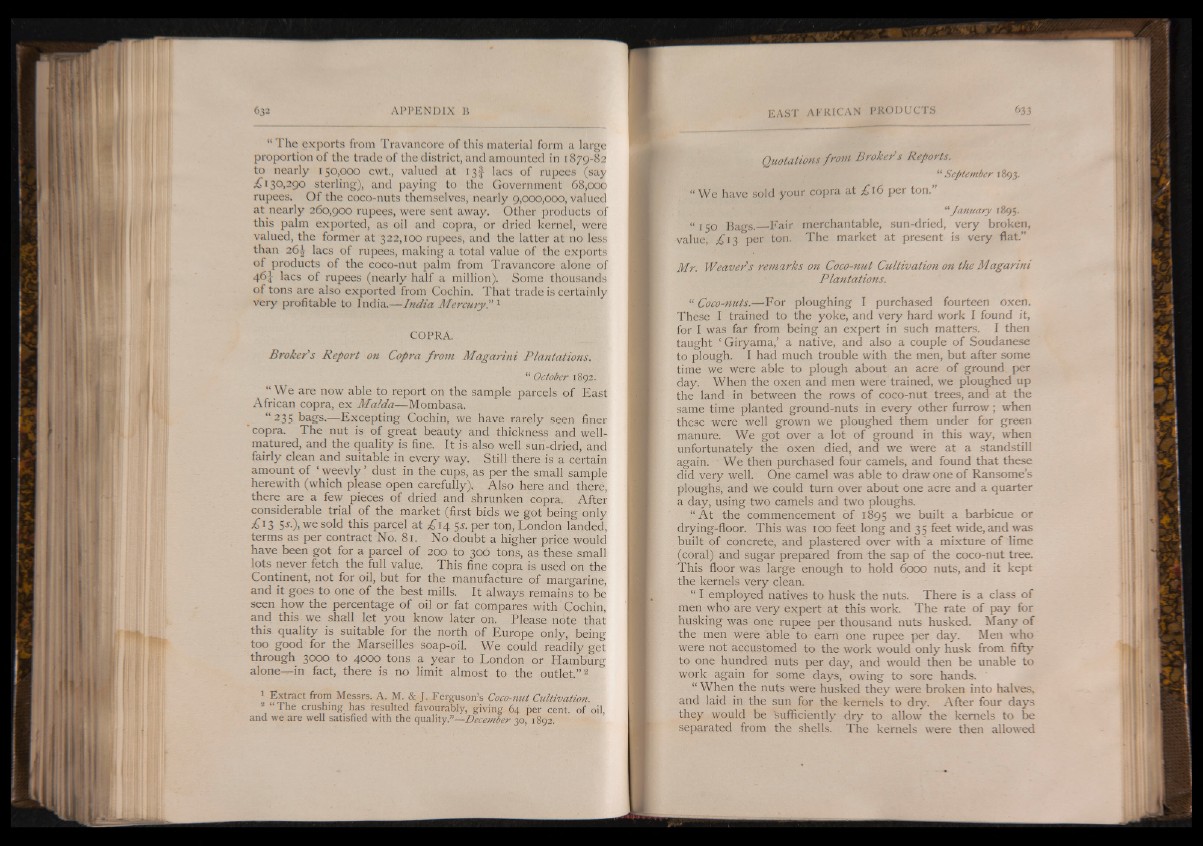
“ The exports from Travancore of this material form a large
proportion of the trade of the district, and amounted in 1879-82
to nearly 150,000 cwt, valued at 13! lacs of rupees (say
£130,290 sterling), and paying to the Government 68,000
rupees. O f the coco-nuts themselves, nearly 9,000,000, valued
at nearly 260,900 rupees, were sent away. Other products of
this palm exported, as oil and copra, or dried kernel, were
valued, the former at 322,100 rupees, and the latter at no less
than 26^ lacs of rupees, making a total value of the exports
of products of the coco-nut palm from Travancore alone of
464 lacs of rupees (nearly half a million). Some thousands
of tons are also exported from Cochin. That trade is certainly
very profitable to India.— India Mercury.” 1
COPRA.
Broker's Report on Copra from Magarini Plantations.
“ October 1892.
“ We are now able to report on the sample parcels of East
African copra, ex Malda— Mombasa.
“ 235 bags.-—Excepting Cochin, we have rarely seen finer
' copra. The nut is of great beauty and thickness and well-
matured, and the quality is fine. It is also well sun-dried, and
fairly clean and suitable in every way. Still there is a certain
amount of ‘ weevly | dust in the cups, as per the small sample
herewith (which please open carefully). Also here and there,
there are a few pieces of dried and shrunken copra. After
considerable trial of the market (first bids we got being only
£13 5^.), we sold this parcel at £14 54. per ton, London landed,
terms as per contract No. 81. No doubt a higher price would
have been got for a parcel of 200 to 300 tons, as these small
lots never fetch the full value. This fine copra is used on the
Continent, not for oil, but for the manufacture of margarine,
and it goes to one of the best mills. It always remains to be
seen how the percentage of oil or fat compares with Cochin,
and this we shall let you know later on. Please note that
this quality is suitable for the north of Europe only, being
too good for the Marseilles- soap-oil. We could readily get
through 3000 to 4000 tons a year to London or Hamburg
alone— in fact, there is no limit almost to the outlet.” 2
1 Extract from Messrs. A. M. & J. Ferguson’s Coco-nut Cultivation.
2 “ The crushing has resulted favourably, giving 64 per cent, of oil,
and we are well satisfied with the quality.”—December 30, 1892.
Quotations from Brokers Reports.
“ September 1893.
“ We have sold your copra at £16 per ton.
“ January 1895.
“ 150 Bags. Fair merchantable, sun-dried, very broken,
value, £13 per ton. The market at present is very flat.”
Mr. Weaver's remarks on Coco-nut Cultivation on the Magarini
Plantations.
“ Coco-nuts.— For ploughing I purchased fourteen oxen.
These I trained to the yoke, and very hard work I found it,
for I was far from being an expert in such matters. I then
taught ‘ Giryama,’ a native, and also a couple of Soudanese
to plough. I had much trouble with the men, but after some
time we were able to plough about an acre of ground per
day. When the oxen and men were trained, we ploughed up
the land in between the rows of coco-nut trees, and at the
same time planted ground-nuts in every other furrow; when
these were well grown we ploughed them under for green
manure. We got over a lot of ground in this way, when
unfortunately the oxen died, and we were at a standstill
again. We then purchased four camels, and found that these
did very well. One camel was able to draw one of Ransome’s
ploughs, and we could turn over about one acre and a quarter
a day, using two camels and two ploughs.
“ A t the commencement of 1895 we built a barbicue or
drying-floor. This was 100 feet long and 35 feet wide, and was
built of concrete, and plastered over with a mixture of lime
(coral) and sugar prepared from the sap of the coco-nut tree.
This floor was large enough to hold 6000 nuts, and it kept
the kernels very clean.
“ I employed natives to husk the nuts. There is a class of
men who are very expert at this work. The rate of pay for
husking was one rupee per thousand nuts husked. Many of
the men were able to earn one rupee per day. Men who
were not accustomed to the work would only husk from fifty
to one hundred nuts per day, and would then be unable to
work again for some days, owing to sore hands.
“ When the nuts were husked they were broken into halves,
and laid in the sun for the kernels to dry. After four days
they would be sufficiently dry to allow the kernels to be
separated from the shells. The kernels were then allowed